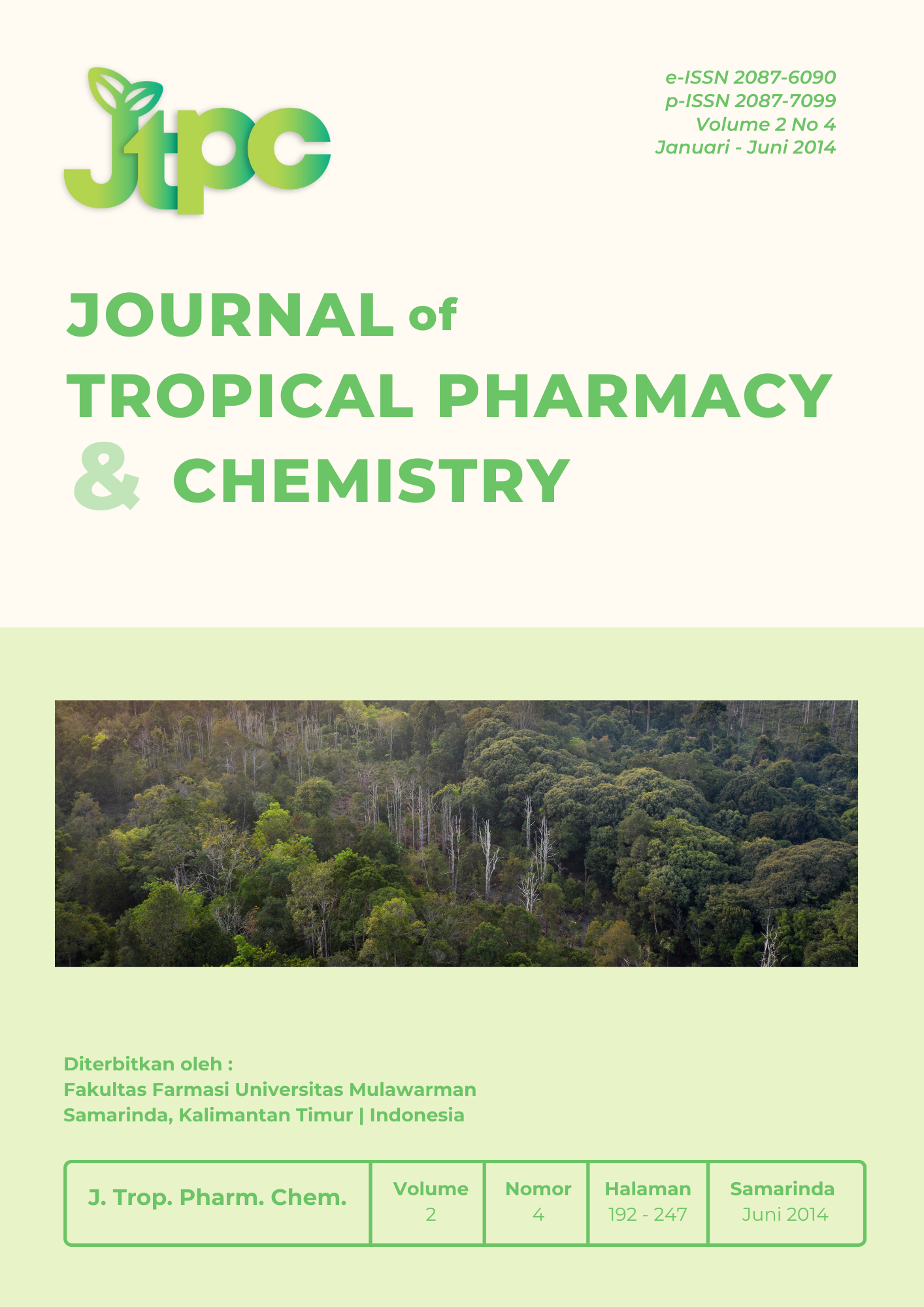Uji Toksisitas Akut Fraksi Etil Asetat Batang Dan Daun Pacar Air (Impatiens balsamina Linn) terhadap Tikus Putih Betina Galur Sprague Dawley
Keywords:
acute toxicity, ethyl acetate fraction, Impatiens balsamina Linn, OECD 425Abstract
Impatiens balsamina Linn has been proven through various studies to have pharmacological benefits. Yet there was no research data regarding the toxicity of these plants. The purpose of this study was to determine the acute toxicity of symptoms that occur after oral administration of ethyl acetate fraction from stems and leaves of Impatiens balsamina Linn, determine the LD50 values ​​and toxicity category compounds in the fraction. This study employed OECD (Organization for Economic, Cooperation and Development) 425 method. Parameters observed qualitatively through the observations of the food and drink intakes and change of body everyday weight during a period of 14 days and microscopic examination of liver and kidney. The results of the study showed no symptoms of toxicity arising from qualitative observations. LD50 value of ethyl acetate fraction of stems and leaves of Impatiens balsamina Linn was more than 2000 mg/kg body weight, which belongs to moderately toxic. Also, a paired t-test concluded that there was no significant differences occuring among the amount of food and drink intakes and body weight changes before and after treatment. Likewise, based on statistical test using One Way ANOVA showed no significant difference in food intakes and body weight changes in the treatment group and control animals (p>0,05), and no significant difference of daily drinking intakes between control group and treatment group with distilled water (p>0,05). While, there was a significant difference between the control rats and the CMC treatment (p <0,05). Based on the results of the scoring damage to liver and kidney showed the ethyl acetate fraction of stem and leaves of Impatiens balsamina Linn histologically caused liver damage, but not for the kidney of the test animals.
Downloads
References
1.Adfa, M., 2006. 6-Metoksi, 7-hidroksi kumarin dari daun pacar air (Impatiens balsaminaLinn.). J Gradien. 2. (2). 183-186.
2.Adfa, M., 2008. Senyawa antibakteri dari daun pacar air (Impatiens balsaminaLinn). J Gradien. 4. (1). 318-322.
3.Baron, W.F., Boulpep, E.L., 2003 Medical Physiology. Philadelphia. Sounders.
4.Baskar, N., Devi, P., Jayakar, B., 2012. Evaluation of antioxidant activity
of ethanol extract of Erythrina variegate and Impatiens balsamina on chromium (VI) induced oxidative stress in albino rats. International Journal of Research in Pharmacology and Pharmacotherapeutics. 1. (1). 31-34.
5.Borkowski B. Thin layer chromatography in the pharmaceutical analysis.
www.intechopen.com. Dalam Szewczyk K, Bogucka A. Analytical methods for isolation, separation and identification of selected furanocoumarins in plant material. 2012. [Dikutip 12 September 2014]: 70-1.
6.Born SL, Caudill D, Smith BJ, et al. In vitro Kinetics of coumarin 3,4-epoxidation: application to species differences in toxicity and carcinogenicity. Toxicol Scie. 2000; 58: 23-31.
7.Chertow GM, Burdick E, Honour M, et al: Acute kidney injury, mortality,
length of stay, and costs in hospitalized patients. J Am Soc Nephrol 16: 3365-3370, 2005.
8.Cornell University Department of Animal Science. Plants poisonous to livestock. 2010. [Dikutip: 20 Desember 2013]. Tersedia dari: http://www.ansci.cornell.edu/plants/toxicagents/kumarin.html
9.Debashree N, Subhalakshmi A, Rita S, Pfuzza A. Study of analgesic and anti-inflamatory effects of Impatiens balsamina leaves in albino rats. International J Pharma and Bio Sciences. Apr 2013; 4 (2): 581-7.
10.Departemen Kesehatan Republik Indonesia. Keputusan Menteri Kesehatan Republik Indonesia Nomor381/MENKES/SK/IIIK/2007 Tentang Kebijakan Obat Tradisional Nasional. Jakarta: Departemen Kesehatan Republik Indonesia. 2007
11.Ding ZS, Jiang FS, Chen NP et al. Isolation and identification of an anti-tumor component from leaves of Impatiens balsamina. Molecules. 2008; 13, ISSN 1420-3049: 220-229.
12.Donatus IA. Toksikologi Dasar. Laboratorium Farmakologi dan Toksikologi, Fakultas Farmasi UGM. Yogyakarta. 2001: 27, 35,37.
13.Evans WJ. Vitamin E, Vitamin C and exercise. Am J Clin Nutr. 2000; 72:
647S-52S.
14.Greig J.B. Sodium carboxymethyl cellulose, enzymatically hydrolysed. International Programme on Chemical Safety. World Health Organization. 1999.
15.Harborne J.B. Metode fitokimia. Bandung: Penerbit ITB; 1987: 102, 111, 147, 238.
16.Hariana HA. Tumbuhan obat dan khasiatnya seri 2. Cetakan 5. Jakarta: Penebar Swadaya; 2008. Hal 151-2.
17.Ishiguro K, Oku H, Kato T. Testosterone 5α-reductase inhibitor bisnaphtoquinone derivative from Impatiens balsamina. J Phytotherapy Research [Internet]. Feb 2000. 14 (1): 54-6. Tersedia dari:
19.Kelly KJ, William JJr, Colvin, et al. Antibody to intercellular adhesion molecule 1 protects the kidney against ischemic injury. Proc Natl Acad Sci U S A. 1994 Jan 18;91(2):812-6. Tersedia dari : http://www.ncbi.nlm.nih.gov/pubmed/7904759.
20.Lake,BG. Coumarin metabolism, toxicity and carcinogenicity: relevance for human risk assessment. Food and Chemical Toxicology [Internet]. Apr 1999; 37(4): 423-53. Tersedia dari: http://www.sciencedirect.com/science /article/pii/S0278691599000101
21.Lake BG. 1984. Investigations into the mechanism of coumarin-induced
hepatotoxicity in the rat. Arch Toxicol. 1984; 7: 16-29. Tersedia dari :
http://www.ncbi.nlm.nih.gov/pubmed/6595978.
22.Lim YH, Kim IH, Seo JJ. In vitro
activity of kaempferol isolated from the Impatiens balsamina alone and in combination with erythromycin or clindamycin against Propionibacterium acnes. J Microbiology. Okt 2007: 45 (5): hal. 437-77.
23.Lu FC. Basic toxicology: fundamentals, target organs and risk assessment. New York: Informa Healthcare USA. 2009. In http://www.sciencedirect.com/science/article/pii/S0378874105003405.
24.Newberne PM, Conner MW, Estes P. The influence of food additives and
related materials on lower bowel structure and function. Toxicol Pathol [Internet]. 1988; 16(2):184-97. Tersedia dari http://www.ncbi.nlm.nih.gov/pubmed/3055228.
25.Ollinger K, Brunmark A. Effect of hydroxy substituent position on 1,4-naphtoquinone toxicity to rats hepatocytes. J Bio Chem. 1991; 32 (15): 21.496-503.
26.Opinion Of The Scientific Committee On Cosmetic Products And Non-Food Products Intended For Consumers. Evaluation and opinion on:Lawsone. European Commission. 2002.




